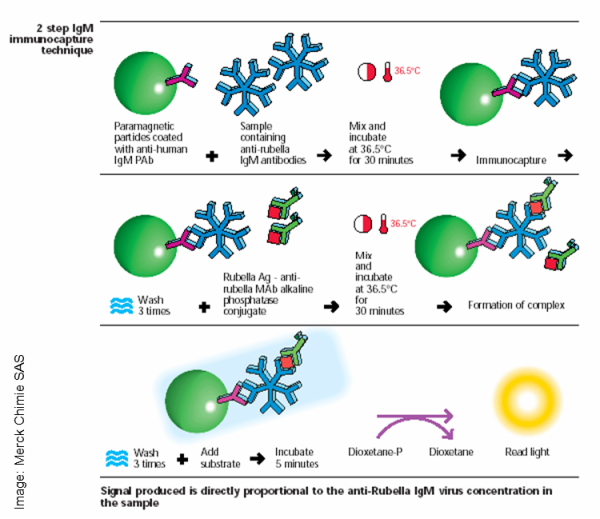The chemiluminescent immunoassay is a technique used for disease diagnosis, drug development, chemical reaction monitoring, and many other applications. The protein or antigen to be identified in these assays is referred to as an analyte. As the name suggests, the assay works by measuring the light produced from a chemical reaction. This chemical reaction is between two reagents, typically a substrate and an oxidant. The reaction produces a product or an intermediate that is unstable and releases a photon as it changes to a lower energy state. One such commonly used system uses a streptavidin substrate that reacts with the oxidant enzyme horseradish peroxidase (HRP). When the HRP enzyme reacts with the streptavidin substrate light is released. This light is then quantified with a detection system.
The immunoassay uses conjugated antibodies to identify the analyte of interest. It is necessary to know exactly what analyte one is trying to find when performing this assay. This is because the substrate (such as streptavidin) is conjugated to an antibody that specifically binds to the analyte. After a substantial amount of incubation time the unbound conjugated antibodies are removed from solution. Before the development of magnetic particles the removal of these excess unbound antibodies was accomplished with columns and filtration, but now there are commercially available magnetic nanoparticles bound with antibodies to recognize analytes. The sandwich technique gets its name because the analyte is sandwiched between an antibody-substrate conjugate and an antibody-magnetic particle conjugate. When the analyte is bound to both conjugates it is a simple task to wash out the unbound conjugates using magnetic separation techniques.
The conjugated analyte sandwiched between the substrate (such as streptavidin) and the magnetic particle is then incubated with the oxidant enzyme (such as HRP) and the amount of chemiluminesce resulting from the reaction is quantified. The amount of analyte in solution is proportional to the amount of chemiluminescence detected.
Related news:
- A collaboration with Bang! Science Magazine
- Reversible aggregation of magnetic particles using a temperature-responsive polymer
- From the Inside Out: Investigating the Layers of a Magnetic Nanoparticle





